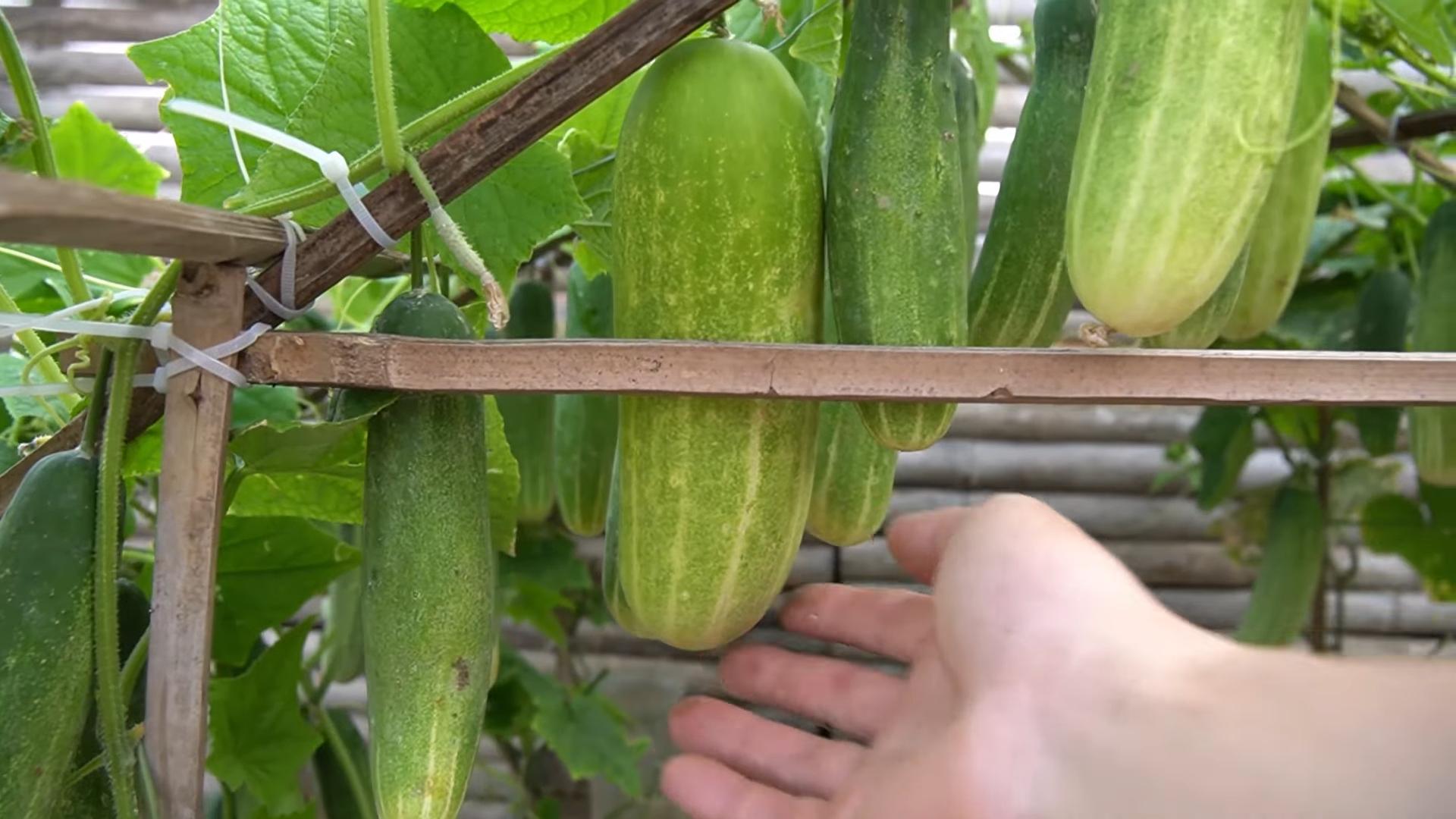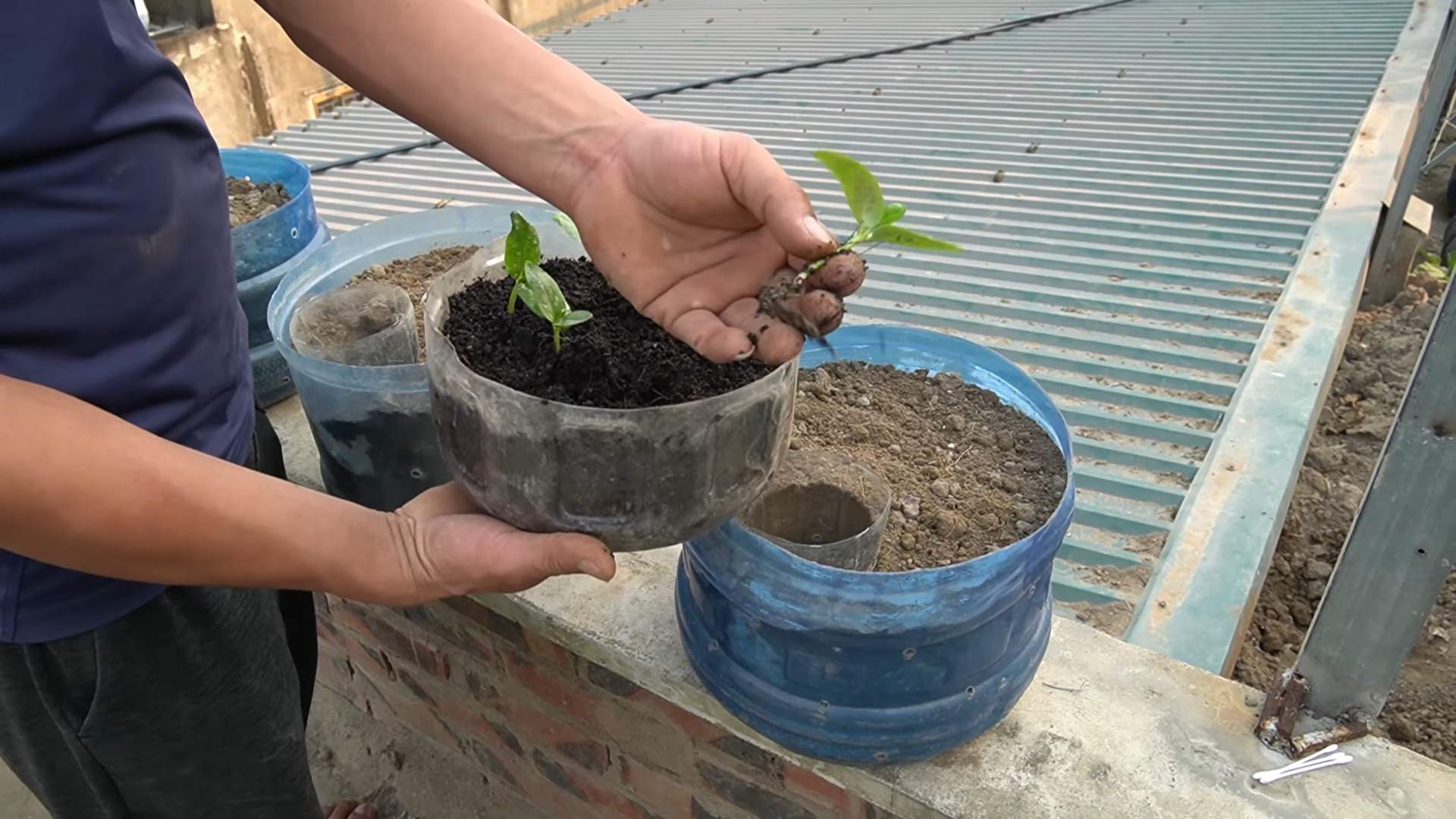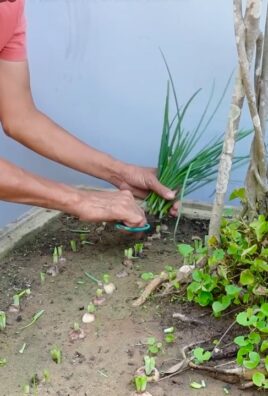Crunchy cucumbers in pots – who wouldn’t want a taste of that fresh, homegrown goodness right from their own balcony or backyard? I know I do! There’s something incredibly satisfying about nurturing a plant from seed to harvest, especially when that harvest is a crisp, refreshing cucumber. For centuries, cultivating cucumbers has been a part of various cultures, from ancient Egypt where they were prized for their cooling properties, to the Roman Empire where emperors demanded them year-round.
But let’s be honest, not everyone has acres of land to dedicate to a sprawling cucumber patch. That’s where the magic of container gardening comes in! This DIY article is your ultimate guide to achieving that perfect crunch, even in the smallest of spaces. We’ll dive into simple, yet effective tricks and hacks that will transform your pots into cucumber-producing powerhouses.
Why do you need these DIY tricks? Because growing crunchy cucumbers in pots isn’t just about throwing some seeds in soil. It’s about understanding the specific needs of these vining vegetables and providing them with the right environment to thrive. From choosing the perfect pot size and soil mix to mastering watering and fertilization techniques, I’m here to share all the secrets I’ve learned along the way. Get ready to enjoy a summer filled with delicious, homegrown cucumbers, no matter how limited your space may be!

Growing Crunchy Cucumbers in Pots: A DIY Guide
Hey there, fellow gardening enthusiasts! I’m so excited to share my secrets for growing the crispiest, most delicious cucumbers right in your own backyard (or balcony!) using pots. Forget those bland, watery grocery store cucumbers – we’re going for maximum crunch and flavor here. This guide will walk you through every step, from choosing the right variety to troubleshooting common problems. Let’s get started!
Choosing the Right Cucumber Variety
Not all cucumbers are created equal, especially when it comes to container gardening. You’ll want to pick a variety that’s compact, disease-resistant, and ideally, bred for smaller spaces. Here are a few of my favorites:
* Bush Champion: This variety is a true winner for pots. It produces a good yield of standard-sized cucumbers on compact vines.
* Spacemaster: As the name suggests, Spacemaster is perfect for limited spaces. It’s a bush type that produces dark green, flavorful cucumbers.
* Patio Snacker: This is a great choice if you want smaller, snack-sized cucumbers. The vines are compact and productive.
* Picklebush: If you’re a fan of pickles, this variety is a must-try! It produces small, blocky cucumbers that are perfect for pickling.
* Little Leaf: This variety is known for its small leaves, which allows for better air circulation and reduces the risk of fungal diseases.
Gathering Your Supplies
Before we dive into the planting process, let’s make sure you have everything you need. Here’s a checklist:
* Pots: Choose pots that are at least 12 inches in diameter and 12 inches deep. Larger is always better, as it gives the roots more room to grow. I prefer using fabric pots, as they allow for better drainage and aeration.
* Potting Mix: Use a high-quality potting mix that’s well-draining and rich in organic matter. Avoid using garden soil, as it can compact in pots and hinder drainage.
* Cucumber Seeds or Seedlings: Select your preferred cucumber variety and purchase seeds or seedlings from a reputable source.
* Trellis or Support: Most cucumber varieties are vining and will need a trellis or other support to climb on. You can use a tomato cage, a bamboo trellis, or even a simple stake.
* Fertilizer: Use a balanced fertilizer that’s specifically formulated for vegetables. I like to use a slow-release fertilizer at planting time and then supplement with a liquid fertilizer every few weeks.
* Watering Can or Hose: You’ll need a way to water your cucumbers regularly.
* Gardening Gloves: Protect your hands from dirt and thorns.
* Optional: Mulch (straw, wood chips, or shredded leaves) to help retain moisture and suppress weeds.
Planting Your Cucumbers
Now for the fun part! Here’s how to plant your cucumber seeds or seedlings:
1. Prepare the Pots: Fill your pots with potting mix, leaving about an inch of space at the top.
2. Sowing Seeds (if starting from seed): Make a small hole about 1 inch deep in the center of the pot. Place 2-3 cucumber seeds in the hole and cover them with potting mix. Gently water the soil.
3. Transplanting Seedlings (if using seedlings): Carefully remove the seedlings from their containers. Gently loosen the roots and place the seedling in the center of the pot. Make sure the top of the root ball is level with the soil surface. Fill in around the seedling with potting mix and gently water the soil.
4. Install the Trellis or Support: Place the trellis or support in the pot behind the cucumber plant. This will give the vines something to climb on as they grow.
5. Mulch (optional): Add a layer of mulch around the base of the plant to help retain moisture and suppress weeds.
Caring for Your Cucumber Plants
Once your cucumbers are planted, it’s important to provide them with the right care to ensure a bountiful harvest.
1. Watering: Cucumbers need consistent moisture to thrive. Water deeply whenever the top inch of soil feels dry to the touch. Avoid overwatering, as this can lead to root rot. I usually water every day or every other day, depending on the weather.
2. Fertilizing: Feed your cucumber plants every 2-3 weeks with a balanced liquid fertilizer. Follow the instructions on the fertilizer label. You can also add compost tea to the soil for an extra boost of nutrients.
3. Sunlight: Cucumbers need at least 6-8 hours of sunlight per day. Place your pots in a sunny location where they will receive plenty of light.
4. Pruning: As your cucumber vines grow, you may need to prune them to encourage branching and fruit production. Remove any yellowing or dead leaves. You can also pinch off the tips of the vines to encourage side shoots.
5. Pollination: Cucumbers are typically pollinated by bees and other insects. If you’re growing cucumbers indoors or in an area with limited pollinators, you may need to hand-pollinate the flowers. To do this, use a small paintbrush to transfer pollen from the male flowers to the female flowers. Male flowers have a long, thin stem, while female flowers have a small cucumber-like structure behind the flower.
6. Pest and Disease Control: Keep an eye out for common cucumber pests and diseases, such as aphids, cucumber beetles, and powdery mildew. If you notice any problems, take action immediately. You can use insecticidal soap or neem oil to control pests. For diseases, try to improve air circulation and avoid overhead watering.
Harvesting Your Cucumbers
The moment we’ve all been waiting for! Here’s how to harvest your cucumbers:
1. Timing: Cucumbers are typically ready to harvest about 50-70 days after planting. The exact timing will depend on the variety and growing conditions.
2. Size: Harvest your cucumbers when they are the desired size and color. Check your seed packet or plant tag for specific information on the size and color of mature cucumbers.
3. Method: Use a sharp knife or pruners to cut the cucumber from the vine. Be careful not to damage the vine.
4. Frequency: Harvest your cucumbers regularly to encourage continued fruit production.
Troubleshooting Common Problems
Even with the best care, you may encounter some problems when growing cucumbers in pots. Here are a few common issues and how to address them:
* Yellowing Leaves: Yellowing leaves can be caused by a variety of factors, including overwatering, underwatering, nutrient deficiencies, and pests. Check the soil moisture and adjust your watering accordingly. Fertilize your plants with a balanced fertilizer. Inspect the leaves for pests and treat them as needed.
* Powdery Mildew: Powdery mildew is a fungal disease that causes a white, powdery coating on the leaves. To prevent powdery mildew, improve air circulation and avoid overhead watering. If you notice powdery mildew, treat it with a fungicide.
* Cucumber Beetles: Cucumber beetles are small, yellow and black beetles that can damage cucumber plants. They can also transmit diseases. To control cucumber beetles, use insecticidal soap or neem oil. You can also cover your plants with row covers to prevent the beetles from reaching them.
* Blossom End Rot: Blossom end rot is a condition that causes the end of the cucumber to rot. It’s typically caused by a calcium deficiency. To prevent blossom end rot, make sure your soil is rich in calcium. You can also add calcium to the soil by using bone meal or eggshells.
* Lack of Fruit: If your cucumber plants are not producing fruit, it could be due to a lack of pollination. Make sure there are plenty of pollinators in your area. You can also hand-pollinate the flowers.
Maximizing Your Cucumber Harvest
Want to take your cucumber growing game to the next level? Here are a few tips for maximizing your harvest:
* Succession Planting: Plant new cucumber seeds or seedlings every few weeks to ensure a continuous harvest throughout the growing season.
* Vertical Gardening: Use a tall trellis or other support to grow your cucumbers vertically. This will save space and improve air circulation.
* Companion Planting: Plant cucumbers with companion plants, such as marigolds, nasturtiums, and basil. These plants can help to repel pests and attract pollinators.
* Water Wisely: Use a soaker hose or drip irrigation to water your cucumbers efficiently. This will help to conserve water and prevent fungal diseases.
* Harvest Regularly: Harvest your cucumbers regularly to encourage continued fruit production.
Enjoying Your Homegrown Cucumbers
Congratulations! You’ve successfully grown crunchy, delicious cucumbers in pots. Now it’s time to enjoy the fruits (or vegetables!) of your labor. Here are a few ideas:
* Eat them fresh: Slice them

Conclusion
So, there you have it! Cultivating crunchy cucumbers in pots isn’t just a gardening trend; it’s a gateway to fresh, flavorful produce right at your fingertips. We’ve walked through the essential steps, from selecting the right variety and pot size to mastering the art of watering and feeding. But why is this DIY trick a must-try?
First and foremost, it democratizes gardening. You don’t need acres of land to enjoy the satisfaction of harvesting your own cucumbers. Whether you have a sprawling balcony, a sunny patio, or even just a well-lit windowsill, you can participate in the joy of growing your own food. Imagine stepping outside and picking a crisp, cool cucumber for your salad, sandwich, or a refreshing snack. The taste difference between homegrown and store-bought is undeniable – a burst of freshness and flavor that will elevate your culinary creations.
Beyond the taste, growing cucumbers in pots offers unparalleled control. You dictate the soil quality, the watering schedule, and the pest management strategies. This means you can ensure your cucumbers are grown organically and free from harmful chemicals. You’re in charge of creating the perfect environment for your plants to thrive, resulting in healthier, more delicious produce.
But the benefits don’t stop there. This DIY project is incredibly rewarding. Watching your tiny seedlings sprout and grow into vibrant, cucumber-laden vines is a truly fulfilling experience. It’s a chance to connect with nature, learn about plant life cycles, and develop a deeper appreciation for the food we eat. Plus, it’s a fantastic way to relieve stress and unwind after a long day.
Ready to take your cucumber cultivation to the next level? Consider these variations:
* Vertical Gardening: Train your cucumber vines to climb a trellis or support structure. This not only saves space but also adds a beautiful vertical element to your garden.
* Companion Planting: Plant basil, marigolds, or nasturtiums alongside your cucumbers to deter pests and attract beneficial insects.
* Pickling Cucumbers: If you’re a fan of pickles, choose a pickling cucumber variety and experiment with different brine recipes.
* Lemon Cucumbers: For a unique twist, try growing lemon cucumbers. These round, yellow cucumbers have a mild, slightly sweet flavor.
Don’t be afraid to experiment and find what works best for you and your growing environment. The beauty of DIY gardening is that it’s all about learning and adapting.
We wholeheartedly encourage you to give this DIY trick a try. It’s a simple, rewarding, and delicious way to bring the joy of gardening into your life. Once you’ve harvested your first batch of crunchy cucumbers, we’d love to hear about your experience! Share your photos, tips, and recipes in the comments below. Let’s create a community of cucumber enthusiasts and inspire others to grow their own food. Happy gardening!
Frequently Asked Questions (FAQ)
What is the best type of cucumber to grow in a pot?
Choosing the right cucumber variety is crucial for success when growing in containers. Bush or compact varieties are generally the best choice because they require less space and are well-suited for smaller pots. Some excellent options include:
* Bush Champion: A classic bush variety that produces high yields of crisp, flavorful cucumbers.
* Spacemaster: As the name suggests, this variety is specifically bred for small spaces and produces abundant cucumbers.
* Patio Snacker: A compact variety that’s perfect for growing on patios or balconies.
* Picklebush: Ideal for pickling, this variety produces small, uniform cucumbers that are perfect for preserving.
* Salad Bush: This variety is known for its early maturity and high yields of delicious salad cucumbers.
When selecting a variety, consider your personal preferences and the size of your pot. Read the seed packet or plant label carefully to determine the plant’s mature size and spacing requirements.
How big of a pot do I need for cucumbers?
The size of the pot is another important factor to consider. Cucumbers need ample space for their roots to grow and develop. A minimum of 5-gallon pot is recommended, but a 10-gallon pot or larger is even better. The larger the pot, the more room the roots have to spread out, which will result in a healthier and more productive plant.
Ensure the pot has adequate drainage holes to prevent waterlogging, which can lead to root rot. You can also add a layer of gravel or pebbles to the bottom of the pot to improve drainage.
What kind of soil should I use for growing cucumbers in pots?
Cucumbers thrive in well-draining, nutrient-rich soil. A good quality potting mix is essential for providing the necessary nutrients and drainage. Avoid using garden soil, as it can be too heavy and compact for container gardening.
Look for a potting mix that contains a blend of peat moss, perlite, and vermiculite. You can also amend the potting mix with compost or other organic matter to improve its fertility and water-holding capacity.
How often should I water my cucumber plants in pots?
Watering is critical for cucumber growth, especially in containers. Cucumbers need consistent moisture to produce juicy, flavorful fruits. Water your cucumber plants deeply whenever the top inch of soil feels dry to the touch.
During hot, dry weather, you may need to water your plants daily or even twice a day. Be sure to water at the base of the plant to avoid wetting the foliage, which can increase the risk of fungal diseases.
How much sunlight do cucumbers need?
Cucumbers need at least 6-8 hours of direct sunlight per day to thrive. Choose a sunny location for your potted cucumbers, such as a south-facing balcony or patio. If you don’t have enough sunlight, you can supplement with grow lights.
How do I fertilize my cucumber plants in pots?
Cucumbers are heavy feeders and require regular fertilization to produce abundant fruits. Start fertilizing your plants a few weeks after transplanting them into their pots. Use a balanced fertilizer, such as a 10-10-10 or 20-20-20, diluted to half strength.
Fertilize your plants every 2-3 weeks throughout the growing season. You can also use a liquid fertilizer or compost tea to provide a boost of nutrients.
How do I deal with pests and diseases on my cucumber plants?
Cucumbers are susceptible to a variety of pests and diseases, including aphids, spider mites, cucumber beetles, and powdery mildew. Regularly inspect your plants for signs of infestation or disease.
If you spot any pests, you can try spraying them with insecticidal soap or neem oil. For fungal diseases, you can use a fungicide or try improving air circulation around your plants.
How do I harvest cucumbers from my potted plants?
Harvest your cucumbers when they are the desired size and color. Use a sharp knife or scissors to cut the cucumbers from the vine, leaving a small stem attached.
Harvesting cucumbers regularly will encourage the plant to produce more fruits. Overripe cucumbers can become bitter and seedy, so it’s best to harvest them when they are still young and tender.
Can I grow cucumbers indoors?
Yes, you can grow cucumbers indoors, but it requires a bit more effort. You’ll need to provide adequate light, either through a sunny window or with grow lights. You’ll also need to pollinate the flowers manually, as there won’t be any bees or other pollinators indoors.
Choose a compact variety that’s well-suited for indoor growing. With proper care, you can enjoy fresh, homegrown cucumbers even in the middle of winter.




Leave a Comment